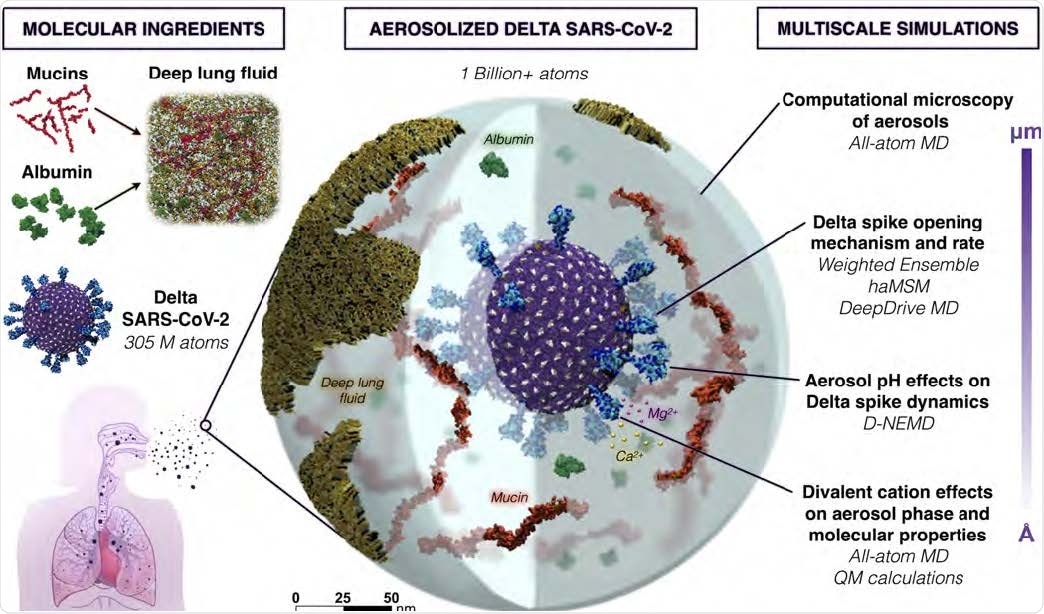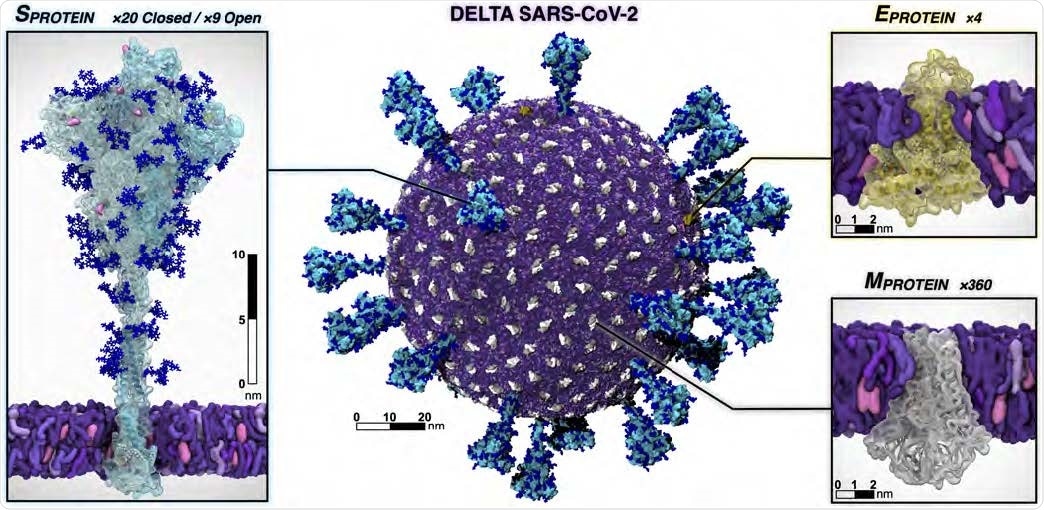
In a paradigm-shifting paper currently available on the bioRxiv* preprint server, the researchers have dramatically extended the possibilities of computational microscopy in order to better understand both structure and dynamics of respiratory aerosols laden with the severe acute respiratory syndrome coronavirus 2 (SARS-CoV-2).
Even though droplets have been seen as the main transmission route for SARS-CoV-2 – a causative agent of the ongoing coronavirus disease (COVID-19) pandemic – it quickly became apparent that airborne transmission also plays a pivotal role in disease spread.
However, the main challenge for understanding airborne transmission has been the inability to reliably examine the structure and dynamics of viruses once they become a part of respiratory aerosol particles.
According to the correct definition, aerosols are smaller than five microns in diameter, and are able to travel significant distances and float in the air for hours (akin to cigarette smoke), and can be inhaled rather easily.
In addition to the different sizes and composition of aerosols, viruses can also be modified to mirror new variants of concern, with various mutations affecting interactions with particular species in the aerosol and subsequently changing its viability and/or structural dynamics.
This is why a recent paper from the Amaro group at the University of California San Diego completely revised contemporary models of viral airborne transmission by providing an unparalleled atomic-level understanding of SARS-CoV-2 within a respiratory aerosol.

Developing a ‘computational microscope’
The approach of these researchers relied on the use of all-atom molecular dynamics simulations as a multiscale ‘computational microscope.’ These types of simulations can give rise to multiple types of biological data (such as multiresolution structural datasets) into cohesive and biologically precise structural models.

And once created, the model can then be approximated to its many atoms, developing trajectories of its time-dependent dynamics under aerosol-like conditions. Furthermore, such simulations can also yield specific parameters that can be incorporated into physical models of aerosols.
“Our approach to simulating the entire aerosol follows a composite framework wherein each of the individual molecular pieces is refined and simulated on its own before it is incorporated into the composite model,” study authors further explain their methodological approach.
First atomic-level views of virus-laden aerosols
This study displayed an extensible multiscale computational framework that spans time and length scales from electronic structure via whole aerosol particle dynamics and morphology. In addition, the researchers have also developed all-atom simulations of respiratory mucins to comprehend the structural foundation of interaction with the SARS-CoV-2 spike glycoprotein.

As a result, this paper puts forth an all-atom simulation that captures massive biological and chemical complexity within a respiratory aerosol. In addition, a described simulation provides the first atomic-level views of aerosols laden with viruses, serving as a basis for developing a plethora of testable hypotheses.
Changes in pH value seen in the aerosol environment may change the dynamics and communication pathways in crucial functional regions of the spike glycoprotein of SARS-CoV-2 (and especially for the Delta strain), while its dramatically open state may facilitate binding to human host cells.
Finally, the study has shown how high-performance computing and cloud resources may speed up scientific efforts and facilitate complex collaborations. Likewise, artificial intelligence can be coupled with high-performance computing at multiple levels to improve effective performance.
Implications for understanding airborne transmission
This work extends the possibility of using multiscale computational microscopy to answer significant questions regarding our understanding of aerosols at the atomic and molecular level, which currently hampers our knowledge of airborne transmission.
“We demonstrate how our integrated data-driven platform provides a new way of exploring the composition, structure, and dynamics of aerosols and aerosolized viruses, while driving simulation method development along several important axes”, say study authors in this bioRxiv paper.
Nonetheless, many technological advances are needed to study even more biologically complex systems that can span from nanometers to one micrometer in size and in longer timescales (i.e., from microseconds to seconds). This is a challenge that needs to be addressed by further studies in the field.
*Important Notice
bioRxiv publishes preliminary scientific reports that are not peer-reviewed and, therefore, should not be regarded as conclusive, guide clinical practice/health-related behavior, or treated as established information.
- Dommer, A. et al. (2021). #COVIDisAirborne: AI-Enabled Multiscale Computational Microscopy of Delta SARS-CoV-2 in a Respiratory Aerosol. bioRxiv. https://doi.org/10.1101/2021.11.12.468428, https://www.biorxiv.org/content/10.1101/2021.11.12.468428v1
Posted in: Microbiology | Medical Science News | Medical Research News | Disease/Infection News
Tags: Artificial Intelligence, Cigarette, Coronavirus, Coronavirus Disease COVID-19, Glycans, Glycoprotein, Membrane, Microscope, Microscopy, Morphology, Pandemic, Peptides, pH, Protein, Respiratory, SARS, SARS-CoV-2, Severe Acute Respiratory, Severe Acute Respiratory Syndrome, Syndrome, Virus

Written by
Dr. Tomislav Meštrović
Dr. Tomislav Meštrović is a medical doctor (MD) with a Ph.D. in biomedical and health sciences, specialist in the field of clinical microbiology, and an Assistant Professor at Croatia's youngest university – University North. In addition to his interest in clinical, research and lecturing activities, his immense passion for medical writing and scientific communication goes back to his student days. He enjoys contributing back to the community. In his spare time, Tomislav is a movie buff and an avid traveler.
Source: Read Full Article